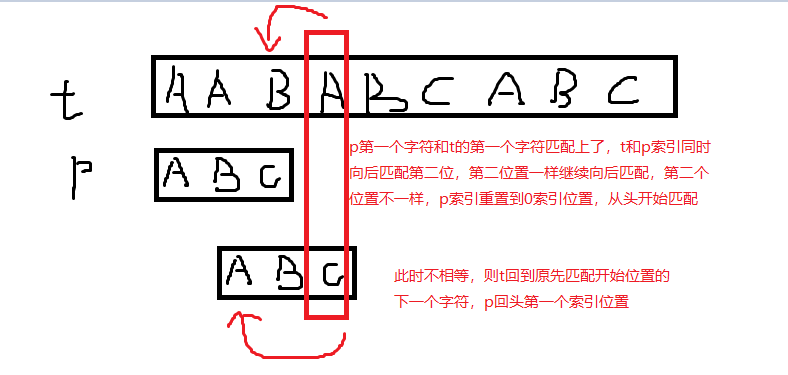Knuth–Morris–Pratt(KMP)是由三位数学家克努斯、莫里斯、普拉特同时发现,所有人们用三个人的名字来称呼这种算法,KMP是一种改进的字符串匹配算法,它的核心是利用匹配失败后的信息,尽量减少模式串与主串的匹配次数以达到快速匹配的目的。它的时间复杂度是 O(m+n)
字符匹配:给你两个字符串 haystack 和 needle ,请你在 haystack 字符串中找出 needle 字符串的第一个匹配项的下标(下标从 0 开始)。如果 needle 不是 haystack 的一部分,则返回 -1
在介绍KMP算法之前,我们先看一下另一种暴力算法(BF算法)去解字符匹配应该怎么做

BF算法:时间复杂度O(m*n)
class Solution: def strStr(self, haystack: str, needle: str) -> int: #hi是haystack的当前索引 hi = 0 haystackLength = len(haystack) needleLength = len(needle) for i in range(haystackLength - needleLength+1): #每次匹配等于和完整的needle的字符串逐一匹配 if haystack[i:i+needleLength] == needle: return i return -1
KMP算法:时间复杂度O(m+n)
KMP构造了一个next列表来对应改位置索引如果匹配失败应该追溯回到什么位置,这样我们讲减少了匹配次数

那么我们如何去构造维护我们的next(最长相同前后缀)
构造方法为:next[i] 对应的下标,为 P[0...i - 1] 的最长公共前缀后缀的长度,令 next[0] = -1。 具体解释如下:
例如对于字符串 abcba:
前缀:它的前缀包括:a, ab, abc, abcb,不包括本身;
后缀:它的后缀包括:bcba, cba, ba, a,不包括本身;
最长公共前缀后缀:abcba 的前缀和后缀中只有 a 是公共部分,字符串 a 的长度为 1
我们通过动态规划来维护next,假设你知道next[0:i-1]位置上所有的回溯值,那么next[i-1]和next[i]相比仅仅多了一个位置,如果这个多的字符可以匹配上,那么next[i]一定等于next[i-1]+1(如下图所示)

那么如果匹配不上呢,匹配不上我们回溯到next[i-1]所需要回溯的位置,直到可以匹配上或到达无法追溯的位置next[0] = -1
@staticmethod def same_start_end_str(p): """ 通过needle串来知道每个索引位置对应的最长前后缀 例如ababa的最长前后缀是aba,前后缀是不和needle等长的最长相同前后缀 """ next = [-1] * (len(p)+1) si = -1 ei = 0 pl = len(p) while ei < pl : if si == -1 or p[si] == p[ei]: si += 1 ei += 1 next[ei] = si else: #无法匹配上,继续向前追溯 si = next[si] return next
那我们有了next就可以取实现我们KMP算法了,完整代码如下
class Solution: def strStr(self, haystack: str, needle: str) -> int: next = self.same_start_end_str(needle) #hi是haystack当前索引,ni是needle当前索引 hi = ni = 0 hl = len(haystack) nl = len(needle) while hi < hl and ni < nl: if ni == -1 or haystack[hi] == needle[ni]: hi += 1 ni += 1 else: ni = next[ni] if ni == nl: return hi - ni else: return -1 @staticmethod def same_start_end_str(p): """ 通过needle串来知道每个索引位置对应的最长前后缀 例如ababa的最长前后缀是aba,前后缀是不和needle等长的最长相同前后缀 """ next = [-1] * (len(p)+1) si = -1 ei = 0 pl = len(p) while ei < pl : if si == -1 or p[si] == p[ei]: si += 1 ei += 1 next[ei] = si else: #无法匹配上,继续向前追溯 si = next[si] return next